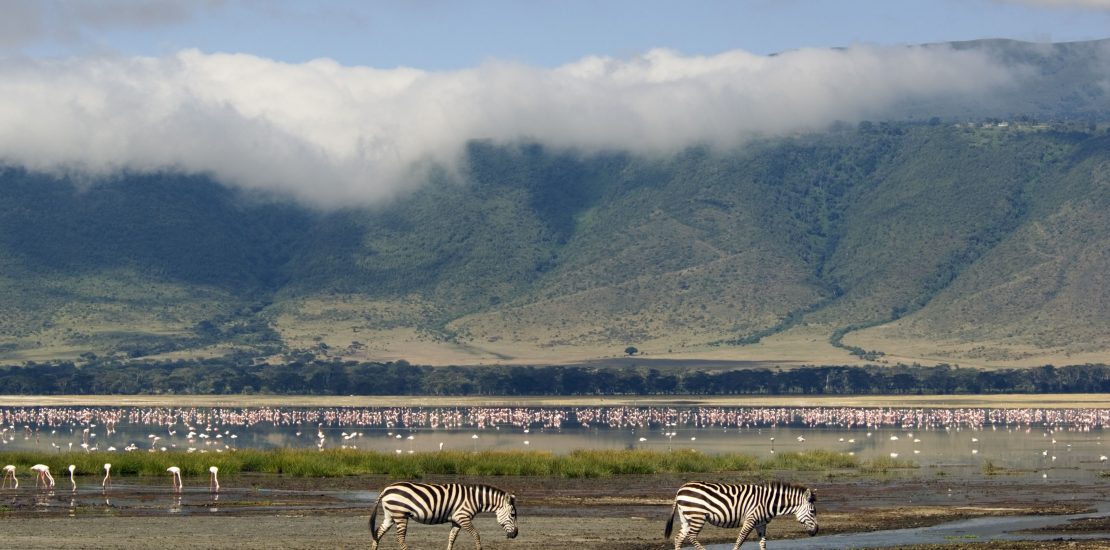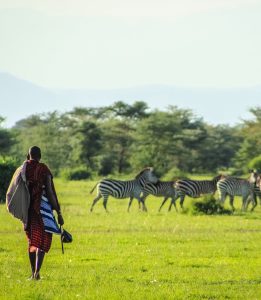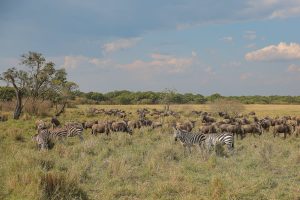- July 29, 2021
- Posted by: Love Uganda Safaris & Tours Ltd
- Category: Uncategorized

What to see and do in Ngorongoro Conservation Area
In this article, you will discover some of the many reasons why you should visit the Ngorongoro Conservation Area. You will also get an insight into the attractions, activities, and accommodation facilities within this magical destination. The article also includes the different ways in which one can access the Ngorongoro Conservation area. You will also get to know some of the facts about the Ngorongoro Conservation Area. For example, Ngorongoro Conservation Area is the only area where humans co-exist with animals in their natural habitats.
Established in 1959, the Ngorongoro Conservation Area in Tanzania is a massive protected area located in the crater highlands of the country. It is said to have been cut off from the Serengeti National Park – the home wildebeest. The crater has an abundance of wildlife making it one of Tanzania’s best safari destinations. This amazing UNESCO World Heritage site lies just about 160 kilometers away from Arusha city.
Ngorongoro Conservation Area lies at the northwestern flank of the mighty Serengeti national park and its boundaries are painted with the amazing beauty of the East African Rift Valley wall. Beautiful wildlife can be spotted within the Lake Ndutu region which acts as the park’s confluence. Ngorongoro Conservation is also close to Lake Manyara national park, Tarangire national park, and Arusha national park. This makes it a center for all tourists to rotate around almost all of Tanzania’s wildlife viewing spots. Click here for an itinerary that covers all these destinations.
Its major attraction
The major attraction within Ngorongoro Conservation Area is the Ngorongoro Crater. It is the world’s largest unbroken volcanic caldera comprising 2,000 feet of depth and 260 square kilometers of width. In addition to the Crater lake, Ngorongoro Conservation Area is home to multiple animal species such as lions, elephants, gazelles, warthogs, rhinos, and hippopotamuses. Other physical features spanning the area include Empakaai crater, Olmoti crater, Lake Magadi, central plains, Lerai forest, Rumbe hills, Munge stream, Mandusi swamp, Gorigor swamp, Ngoitokitok springs, Gol Mountains, Mount Lolmalasin and Losirua, Lake Ndutu, Lake Maseke, Olkarien gorge, and the shifting sands. For bird lovers, Ngorongoro Conservation Area is a prime birding destination and is home to multiple bird species some of which are migratory (can only be seen during specific seasons) while others are Rift Valley endemics and others are elusive species.
History of the area
Oscar Baumann was the first European to visit the area. Later the German brothers; Friedrich Siedentopf and Adolf came to settle and farmed until World War I. These people were later driven out of the crater area by the Masaai people in the 1800s.
The interest in protecting the wildlife in the crater area led to the upbringing of an ordinance in 1921 to restrict hunting in the park. Then, in 1951 there was an Ordinance of Serengeti national park and in 1979, the ordinance of the Ngorongoro crater area happened.
The area was separated from Serengeti national park to protect the wildlife and at the same time give land for settlement for the Masaai. Later in 1974, the crater area was listed as a UNESCO world heritage site. In the later years, conservation efforts for the Ngorongoro conservation area are still in check to protect the wildlife in the area putting in mind the compensation of the Masaai people. Until now, the Masai people co-exist with the wildlife ecosystem, and the relationship is classified as a harmonious one. The give-back to the community programs has played a greater role in maintaining the relationship.
The Ngorongoro crater area
The Ngorongoro conservation area covers an area of 8,292 square kilometers. It is located near the Serengeti national park and the nearby city of Arusha town. The main attraction and highlight of the conservation area is the Ngorongoro crater.
The crater is the world’s largest inactive caldera with of an area 260 square kilometers of the floor. The crater floor is 1800 kilometers above sea level.
The term Ngorongoro comes from a local idea of the first Masai, the term came from a cowbell sound (Ngoro Ngoro) for the Masaai were the major pastoralists of the area.
The Ngorongoro crater attracts thousands of travelers from all the corners of the world throughout the year. These enjoy spectacular views of the soda ash Lake Magadi which is home to thousands of flamingo birds. Having a picnic from this Lake is something that you will never forget for the rest of your life. The area has other crater lakes such as the Empakai Caldera and Olmoti Caldera which provide scenic game-viewing experiences. The lakes that make up the Ngorongoro crater have played a significant role in feeding the vast wildlife as well as human beings that dwell within the region. For any ecosystem to exist in a given area, there is need always a need for a reliable source of water. Initially, the lake did not exist until volcanic eruption took place and the hollow area was filled with water forming the world’s largest Caldera.
Activities in the area
Game viewing
Ngorongoro Game Park is home to a wide range of wildlife. The crater is home to about 25000 wildlife mammals. These include the wildebeest, Zebra, rhinos, lions, buffaloes, hippos, and many more.
Visiting Ngorongoro Conservation Area will give you an opportunity to see large herds of animals such as zebras, gazelles, and wildebeests. Some of these animals cross all the way from Serengeti national park as they head northwards to Kenya’s Masai Mara Game Reserve.
One of the reasons why Ngorongoro Conservation Area has remained a top animal biosphere is the variations in altitude, climate, and landforms. Within the lowlands which are covered by short grass, many of the park’s animals find it easy to stay and graze. The predators of the park such as lions, leopards, hyenas, and wild dogs are also residents since they make life through hunting the herbivores.
A safari game drive in Ngorongoro Conservation Area will introduce you to the daily life of these animals in their natural habitats. On a lucky day, you will see a pride of lions killing a zebra or a leopard taking its kill in the high tree branches.
Birding in Ngorongoro Conservation Area
A birding experience in the Ngorongoro conservation area is one of the exceptional activities not to miss on a Tanzania wildlife safari. There are over 287 bird species in the area with 2 endemic species and 8 near-endemic species. Birds in this region include the Augur buzzard, Rosy throated long claw, fan-tailed widowbird, Black-winged lapwing, Hildebrandt’s starling. Verreaux eagle, scarlet-chested sunbird, northern anteater chat, Egyptian vulture, greater flamingo, and many others. The best time for bird watching is from the month of November to April.
Cultural encounters in Ngorongoro Conservation Area

The Ngorongoro conservation area has been home to a number of indigenous tribal people. A visit to the Masaai people can be a rewarding activity. Exploring the culture and traditions. A visit to this cultural community gives a chance to witness and experience the traditional dances, a tour of the village, and an interesting narrative about the Masai people.
Hot Air balloon safari in Ngorongoro Conservation Area
The beautiful landscape and wildlife of Ngorongoro conservation area can be in another exciting and different way. The air balloon safari though quite expensive is a big adventure not to miss out on a Tanzania safari, especially in Ngorongoro Conservation Area. This gives travelers a chance to view the crater while covering a larger area and seeing more wildlife and beautiful landscapes. Hot air balloon safaris in Africa are one of the best safari experiences as they give tourists a bossy feeling. They usually come with breakfast in the bush or Sundowners on special arrangements. This is one of the safari activities that honeymooners ought not to miss during their African wildlife safaris.
In the event that you want a bush breakfast or Sundowners on your safari, let us know in time so that you do not miss such an amazing safari experience.
Attractions in Ngorongoro conservation area
Leria fever tree forest
This is one of the unique attractions located in the conservation area. This forest consists of a rare acacia tree species. The acacia type located in the Leria fever is tall, yellow in color, and small in size. The forest is the best spot to sight the black rhinos, hyrax, bushbucks, and elephants.
Lake Magadi
Lake Magadi is a magical destination for birders in Tanzania. This is one of the bird paradises in the country. Its swallow base is home to a number of wading birds including the famous pink flamingos and pelicans. The lake also attracts hundreds of other wild animals as they come to quench their thirst. On the other hand, predators come over majorly for hunting reasons.
Olmeti and Empakaai crater
This shallow crater is ideal for hiking and nature walks around the Ngorongoro Conservation Area. It is a grazing ground for Masai herdsmen and also happens to provide excellent wildlife views. This caldera is 6 kilometers wide. The crater attracts a number of birds and wildlife. These include the flamingos that come to the area due to algae, blue monkeys, water bucks, hyenas, bushbucks, and many others.
Olduvai Gorge
The Olduvia gorge is an important archeological site. This is where the first remains of hominids were found by Richard Leakey in the early 20th century. A visit to this site gives an opportunity to see the 3 million-year-old hominid footprints on a volcanic rock. This area has made Ngorongoro Conservation Area a top research destination and a learning center for students from all corners of the world.
The Big five
Other than having multiple wildlife species, Ngorongoro Conservation Area has gained fame for being home to the big five animals. The big five animals are; lion, leopard, elephant, African buffalo, and rhino. They are referred to as the big five animals because they are difficult to be hunted down. Are you passionate about seeing one of these world-respected species? Consider adding Ngorongoro Conservation Area to your travel destinations list.
What is the best time to Visit Ngorongoro Conservation Area?

Ngorongoro Conservation Area is an open destination for all travelers from all parts of the world throughout the year. The area can be visited either during the dry months of May to October or during the rainy season. This runs from November to April. Embarking on a game drive in this area during the wet season gives you a chance to enjoy great animal views. They tend to be in a more relaxed mood enjoying the green grass. On the other hand, visitors who come during the dry season get clear views of the expanse of land and aerial views are clearer. Animals can easily be seen on the water sources such as Lake Ndutu, Lake Magadi and Ngorongoro Crater.
Generally, the area is open thus when to visit remains in the hands of the travelers.
How to access Ngorongoro Conservation Area?
Getting to Ngorongoro Conservation Area should not be one of your worries while planning an African safari. There are two alternatives. The area can be accessed by both road and air means.
By road, travelers drive for 2 hours from Arusha using 4×4 safari vehicles. The driving distance is approximately 160 kilometers.
By air, you can get domestic flights from Kilimanjaro airport. And connect to any of the airstrips within Ngorongoro Conservation Area.
Accommodation
Whether you are traveling as family, couple, solo traveler, backpacker, or a group of students, where to stay in Ngorongoro Conservation Area should not scare you. This is because the accommodation facilities within and nearby are accessible and affordable. They start from campsites to budget lodges to mid-range and then luxury or high end safari lodges. Meals depend on how you have booked though many of the accommodation facilities include meals on amount charged for sleeping over.
Is it possible to combine the Ngorongoro Conservation Area safari with other national parks in Tanzania?
The fact that Ngorongoro Conservation is almost at the Center of Arusha national park, Tarangire national park, Lake Manyara national park and Serengeti national park. It becomes easy for travelers to combine this amazing destination with other Tanzania safari destinations.
This is why you need an experienced tour operator like Love Uganda Safaris &Tours Ltd to organize for you a tailor-made safari package which will give you an opportunity to explore as many destinations as possible.
Facts about Ngorongoro Conservation Area
- It is only in Ngorongoro Conservation Area that man co-exists with wildlife in the same area.
- It is a home of the Big 5 animals (lion. Leopard, African buffalo, rhino and elephant)
- It is here that the first remains of man were discovered (at Olduvai Gorge)
- Ngorongoro crater is the world’s largest volcanic Caldera
In a nutshell, the Ngorongoro conservation area is one of the best tour, nature, and wildlife destinations not to miss out on a Tanzania safari. In case you have been planning a trip to Africa, it’s high time you visited this amazing destination.
Leave a Reply
You must be logged in to post a comment.
